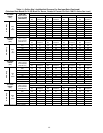The blower door must be installed for power to be conducted
through the blower door interlock switch ILK to the furnace
control CPU, transformer TRAN, inducer motor IDM, blower
motor BLWM, hot-surface igniter HSI, and gas valve GV.
1. Heating
(See Fig. 24 for thermostat connections.)
The wall thermostat ″calls for heat″, closing the R to W
circuit. The furnace control performs a self-check, verifies the
pressure switch contacts PRS is open, and starts the inducer
motor IDM.
a. Inducer Prepurge Period- As the inducer motor IDM
comes up to speed, the pressure switch contacts PRS close,
24 vac power is supplied for a field installed humidifier at
the HUM terminal and the control begins a 15-second
prepurge period.
b. Igniter Warm-Up- At the end of the prepurge period, the
Hot-Surface Igniter HSI is energized for a 17-second
igniter warm-up period.
c. Trial-for-Ignition Sequence- When the igniter warm-up
period is completed the main gas valve relay contacts GVR
close to energize the gas valve GV, the gas valve opens.
The gas valve GV permits gas flow to the burners where it
is ignited. After 5 seconds, the igniter HSI is de-energized
and a 2-second Flame-Proving period begins.
d. Flame-Proving- When the burner flame is proved at the
flame-proving sensor electrode FSE, the furnace control
CPU begins the blower-ON delay period and continues to
hold the gas valve GV open. If the burner flame is not
proved within two seconds, the control CPU will close the
gas valve GV, and the control CPU will repeat the ignition
sequence for up to three more Trials-For-Ignition before
going to Ignition-Lockout. Lockout will be reset auto-
matically after three hours, by momentarily interrupting
115 vac power to the furnace, or by interrupting 24 vac
power at SEC1 or SEC2 to the furnace control CPU (not at
W, G, R, etc.)
If flame is proved when flame should not be present, the
furnace control CPU will lock out of Gas-Heating mode
and operate the inducer motor IDM until flame is no longer
proved.
e. Blower-On Delay- If the burner flame is proven, the
blower motor is energized on HEAT speed 25 seconds after
the gas valve GV is energized.
Simultaneously, the electronic air cleaner terminal EAC-1
is energized and remains energized as long as the blower
motor BLWM is energized.
f. Blower-Off Delay- When the thermostat is satisfied, the
R-to-W circuit is opened, de-energizing the gas valve GV,
stopping gas flow to the burners, and de-energizing the
humidifier terminal HUM. The inducer motor IDM will
remain energized for a 5-second post-purge period. The
blower motor BLWM and air cleaner terminal EAC-1 will
remain energized for 90, 120, 150, or 180 seconds (depend-
ing on the blower-OFF delay selection). The furnace
control CPU is factory-set for a 120-second blower-OFF
delay.
2. Cooling Mode
(See Fig. 24 for thermostat connections)
The thermostat closes the R-to-G-and-Y circuits. The R-to-Y
circuit starts the outdoor unit, and the R-to-G and Y circuits
start the furnace blower motor BLWM on COOL speed.
The electronic air cleaner terminal EAC-1 is energized with
115 vac when the blower motor BLWM is operating.
When the thermostat is satisfied, the R-to-G-and-Y circuits are
opened. The outdoor unit will stop, and the furnace blower
motor BLWM will continue operating on the COOL speed for
an additional 90 seconds. Cut jumper J2 to reduce the cooling
off-delay to 5 seconds. (See Fig. 23.)
3. Continuous Blower Mode
When the R-to-G circuit is closed by the thermostat, the
blower motor BLWM will operate on continuous-blower
speed (same as HEAT speed). Terminal EAC-1 is energized as
long as the blower motor BLWM is energized.
During a call for heat, the blower BLWM will stop during
igniter warm-up (17 seconds), ignition, and blower-ON delay
(25 seconds), allowing the furnace heat exchangers to heat up
more quickly, then restarts at the end of the blower-ON delay
period at HEAT speed.
When the thermostat ″calls for cooling″, the blower motor
BLWM will operate at COOL speed. When the thermostat is
satisfied, the blower motor BLWM will operate an additional
90 seconds on COOL speed before reverting back to
continuous-blower speed.
When the R-to-G circuit is opened, the blower motor BLWM
will continue operating for an additional 5 seconds, if no other
function requires blower motor BLWM operation.
4. Heat Pump
When installed with a heat pump, the furnace control auto-
matically changes the timing sequence to avoid long blower
off times during demand defrost cycles. When the R-to-W-
and-Y or R-to-W-and-Y-and-G circuits are energized the
furnace control CPU will continue to turn on the blower motor
BLWM at HEAT speed, and begin a heating cycle. The
blower motor BLWM will remain on until the end of the
prepurge period, then shut off for 24 seconds then come back
on at HEAT speed. When the W input signal disappears, the
furnace control begins a normal inducer post-purge period and
the blower switches to COOL speed after a 3 second delay. If
the R-to-W-and-Y-and-G signals disappear at the same time,
the blower motor BLWM will remain on for the selected
blower-OFF delay period. If the R-to-W-and-Y signals disap-
pear, leaving the G signal, the blower motor BLWM will
continue running the blower motor BLWM at HEAT speed
after the selected blower-OFF delay period is completed.
Step 4—Wiring Diagrams
Refer to Fig. 24 and 39 for wiring diagrams.
Step 5—Troubleshooting
Refer to the service label. (See Fig. 43—Service Label.)
The Troubleshooting Guide can be a useful tool in isolating
furnace operation problems. Beginning with the word “Start,”
answer each question and follow the appropriate arrow to the next
item.
The Guide will help to identify the problem or failed component.
After replacing any component, verify correct operation sequence.
35


















